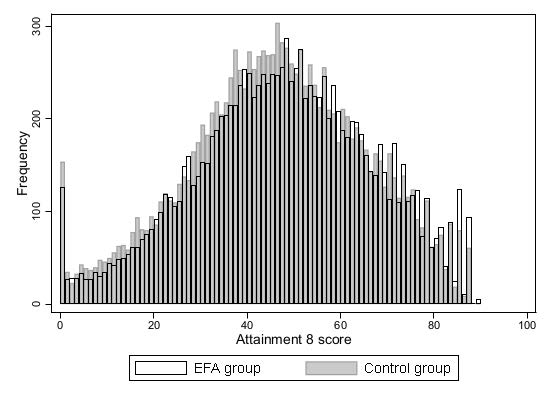The effect of embedding formative assessment on pupil attainment
Jake Anders, Francesca Foliano, Matt Bursnall, Richard Dorsett, Nathan Hudson, Johnny Runge, and Stefan Speckesser
What is formative assessment?
'Formative assessment', often used interchangeably with the term 'assessment for learning' and in contrast to 'summative assessment', refers to assessment activities undertaken by teachers – or students themselves – to obtain evidence which is then used to adapt teaching and learning methods to meet student needs and improve learning outcomes.
What is Embedding Formative Assessment (EFA)?
EFA is a professional development program for schools that aims to support high school teachers to embed formative assessment strategies in their practice to improve pupil learning outcomes. The program consists of light-touch training and support, with most of the work done by teacher-led teaching and learning communities (TLCs) within schools, which most schools arrange during time already dedicated to professional development. Each workshop involves teachers reporting on their use of techniques since the last workshop, sharing new formative assessment ideas to try, and personal action planning for the coming month. There is guidance on structure and content for these meetings. In addition, teachers are asked to pair themselves for monthly peer lesson observations between workshops.
What did this study find about EFA?
In our study, schools that implemented EFA saw higher pupil attainment than those in the control group. Our results are encouraging for this approach to improving teachers’ implementation of formative assessment in the classroom and, hence, pupils’ academic attainment. The size of the difference between the EFA and control groups is equivalent to almost two months of pupil learning: especially worthwhile given the context of this as a low-cost, scalable program. The size of the effect was slightly larger among pupils with lower levels of prior attainment.

Chart notes: The chart shows the distribution of pupil attainment in their best 8 subjects on age 16 national examinations by whether pupils were in a school that was assigned to EFA or a control school. Pupils in EFA schools achieve higher scores, on average. Since schools were assigned to these two groups at random, with the only systematic change being schools’ receipt of the EFA program, we expect that this difference is attributable to the EFA program.
How did we carry out the study?
70 high schools were allocated to receive EFA, while 70 high schools were allocated to receive a substitute payment, which they could put to any purpose (except EFA). This allocation was carried out at random, making this a randomized controlled trial (RCT). RCTs are widely considered a high standard of evidence since they are designed to minimize the potential for bias in our estimate of effectiveness. Our pupil attainment outcome measure was obtained from state-mandated tests of pupils at age 16, providing a seldom missing and highly relevant outcome measure.
Full Article Citation:
Anders, J., Foliano, F., Bursnall, M., Dorsett, R., Hudson, N., Runge, J., & Speckesser, S. (2022). The effect of embedding formative assessment on pupil attainment. Journal of Research on Educational Effectiveness. DOI: https://doi.org/10.1080/19345747.2021.2018746.
